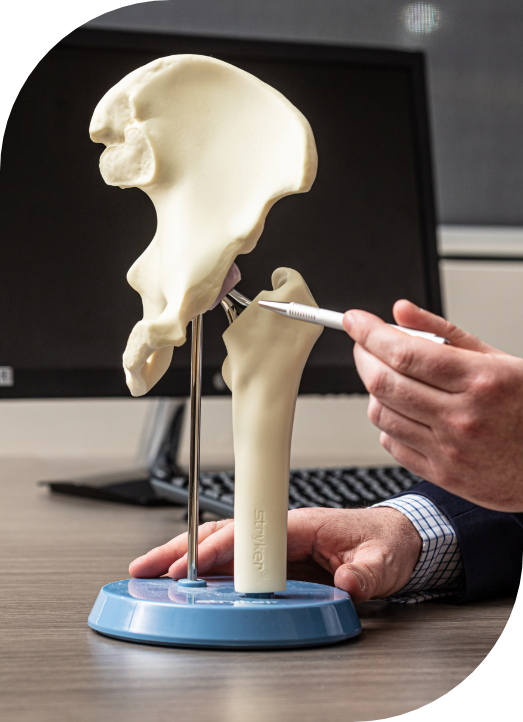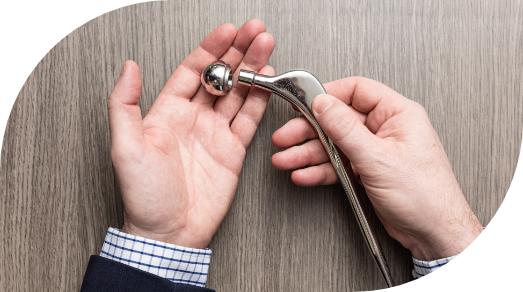Total Hip Replacement
The hip joint is one of the main weight-bearing joints in the body. It is a ball-and-socket joint. Total Hip Replacement is a procedure that removes the damaged joint surfaces and replaces the joint with artificial material called a prosthesis.
The most common disease process affecting the hip joint is osteoarthritis. Less common causes of hip arthritis include rheumatoid arthritis, spondyloarthropathies, avascular necrosis, fracture and post-traumatic arthritis.
The most common symptom of hip arthritis is pain. Many patients will also suffer from hip stiffness or contracture. These symptoms can impact on your quality of life and daily function. Patients with advanced hip arthritis may experience:
- Painful weight bearing
- Reduced walking distance
- Stiffness
- Limping
- Difficulty reaching their feet
- Night pain
- Avoidance of usual leisure activities

How do I know if I need a hip replacement?
The main indication for proceeding to Total Hip Replacement surgery is when the pain impacts on your quality of life and daily function. When simple non-operative measures fail to relieve your symptoms then surgery may be indicated.
Total Hip replacement is one of the most successful elective surgery procedures in terms of quality of life improvement. Approximately 95% of patients are satisfied with the outcome of their hip replacement.
Dr Woodbridge places significant emphasis on a careful assessment of your history, examination findings and radiographic features. Dr Woodbridge aims to educate and involve his patients in the decision-making process.

The Operation
After anaesthesia is performed, the hip joint is exposed through a surgical approach. The hip is dislocated and the femoral head (ball) is cut and removed. The socket (acetabulum) is carefully reamed to remove any remaining cartilage. An artificial cup is inserted into the socket. This metal cup is held with a rough porous coating that grips the bone and is specially designed to allow your bone to grow into it to provide long-term fixation. A liner made from ceramic or especially wear-resistant plastic called polyethylene is inserted into the cup.
The femoral canal of the thigh bone is then prepared. This allows a stem (femoral component) to be inserted into the canal. The stem is fixed to the canal with either bone cement or a rough porous coating. A ceramic or metal ball (head) is attached to the stem. The soft tissues are then repaired and the wound is closed with absorbable sutures.
The soft tissues are then repaired and the wound is closed with absorbable sutures.
What happens after the operation?
Your hip will be able to bear weight from day 1. Physiotherapists will guide you through the process of using a walking frame and progressing to crutches. There are also specific exercises that will begin immediately and progress over a number of weeks. Some patients may elect to attend a rehabilitation unit after a few days to receive additional physiotherapy guidance. It is also possible to visit your physiotherapist in the community.
Driving
Patients should not return to driving until they can reliably perform an ‘emergency stop’ and when they are no longer taking regular narcotic analgesia. On average, patients can return to driving at around 4-6 weeks after surgery.
How Long Does a Hip Replacement Last?
Australia’s National Joint Registry has been keeping accurate records of revision rates for the past 20 years. Many people will be relieved to know that hip replacements seem to be lasting longer than the traditionally held views on longevity. On average at 20 years, almost 90% of hip replacements are still functioning. This is likely the result of improvements in materials and design of implants, as well as more accurate implantation over recent decades.
Dr Woodbridge uses a prosthesis that has a low revision rate with an established track record.


